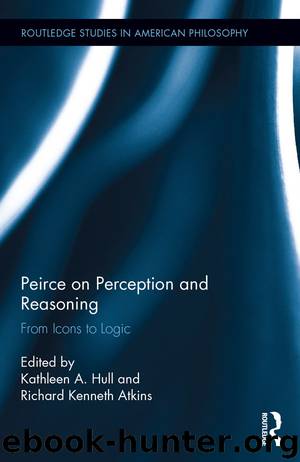Peirce on Perception and Reasoning by Hull Kathleen A.; Atkins Richard Kenneth;

Author:Hull, Kathleen A.; Atkins, Richard Kenneth;
Language: eng
Format: epub
Publisher: Taylor and Francis
Published: 2017-02-23T05:00:00+00:00
Notes
1The Catalogue of the Officers and Students of Harvard University for the Academic Year 1861–62 lists Peirce’s father, a founding force behind the Lawrence Scientific School, as “Benjamin Peirce, LL.D., Parkman Professor of Astronomy and Mathematics” (6). His son’s chemistry tutor, Josiah P. Cooke, is listed as Erving Professor of Chemistry and Mineralogy. There are fifty-seven “scientific students” (71–73), including “Peirce, Charles S., A.B,” studying chemistry. The catalogue outlines the curriculum for each subject. The entry under chemistry states that the course of instruction will include “recitations in Experimental Chemistry, Qualitative Analysis, Chemical Physics, and the Applications of Chemistry to the Arts” (75). The academic lectures available included chemistry, physics, botany, and anatomy as well as laboratory sessions to do with chemical analysis, manufacturing chemistry, metallurgy, and pharmacy. Of particular interest are the textbooks that were used as these give some insight into the content of the chemistry curriculum. Students were expected to have an acquaintance with Stöckhardt’s Principles of Chemistry (1854), in addition to Cooke’s Chemical Physics (1860) and Regnault’s Elements of Chemistry (1853). As we will show later on, these textbooks provide a glimpse into Cooke’s pedagogical innovations at Harvard.
2The idea of Berzelian formulae (a modification of which is still in use in contemporary chemistry) as “paper tools” has been proposed by Ursula Klein (2001a, 2001b, and 2003) and will be discussed later on.
3This is partly related to Cooke’s Unitarian views, which developed in a sophisticated epistemological framework aimed at reconciling science and religion. Cooke worked at the very time in which the reception of Darwin’s Origin of Species in America prompted either the complete abandonment of traditional natural theologies or, as in the case of Peirce’s own mentor Louis Agassiz, the production of explicit criticisms of Darwin’s ideas. As shown by Contakes and Kyle (2011), Cooke saw science and religion as complementary epistemologies, and mathematics, in his account, offered an indispensable key to this complementarity.
4It is not quite clear why Cooke’s title refers to “Elements” rather than “Principles” of chemistry, as in Stöckhardt’s original. The examples and citations he gives from Stöckhardt confirm that the text he is referring to is the Principles of Chemistry.
5Notice, too, in passing that Cooke represents chemical change as an equation with an “equals” sign (=) separating the reactants from the products. The introduction of arrows to show the direction of change was not made until 1884 by the Dutch chemist Jacobus van’t Hoff in his book on chemical equilibrium Étude de Dynamique Chemique (Studies in Chemical Dynamics), where double reversed arrows were used to indicate reversible reactions and the dynamic nature of chemical equilibrium.
6Three-dimensional models of the kind Cooke suggests to his students were ubiquitous in nineteenth century teaching and research. For a historical overview of the various uses of these kinds of models across scientific disciplines, see De Chadarevian and Hopwood (2004).
7The literature on Kant and Peirce is vast, and here we limit ourselves to point the reader to Gava (2014) as an excellent and up-to-date source on the subject.
Download
This site does not store any files on its server. We only index and link to content provided by other sites. Please contact the content providers to delete copyright contents if any and email us, we'll remove relevant links or contents immediately.
| Anthropology | Archaeology |
| Philosophy | Politics & Government |
| Social Sciences | Sociology |
| Women's Studies |
The remains of the day by Kazuo Ishiguro(8739)
Tools of Titans by Timothy Ferriss(8155)
Giovanni's Room by James Baldwin(7114)
The Black Swan by Nassim Nicholas Taleb(6946)
Inner Engineering: A Yogi's Guide to Joy by Sadhguru(6633)
The Way of Zen by Alan W. Watts(6450)
Asking the Right Questions: A Guide to Critical Thinking by M. Neil Browne & Stuart M. Keeley(5577)
The Power of Now: A Guide to Spiritual Enlightenment by Eckhart Tolle(5544)
The Six Wives Of Henry VIII (WOMEN IN HISTORY) by Fraser Antonia(5358)
Astrophysics for People in a Hurry by Neil DeGrasse Tyson(5095)
Housekeeping by Marilynne Robinson(4252)
12 Rules for Life by Jordan B. Peterson(4218)
The Ethical Slut by Janet W. Hardy(4147)
Double Down (Diary of a Wimpy Kid Book 11) by Jeff Kinney(4143)
Skin in the Game by Nassim Nicholas Taleb(4122)
Ikigai by Héctor García & Francesc Miralles(4044)
The Art of Happiness by The Dalai Lama(4009)
Skin in the Game: Hidden Asymmetries in Daily Life by Nassim Nicholas Taleb(3867)
Walking by Henry David Thoreau(3858)
